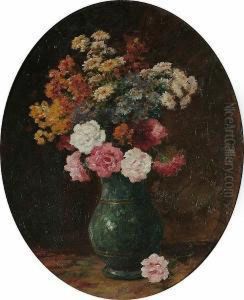Eugene Richet Paintings
Eugène Richet was a French artist known primarily for his landscape paintings. Born in 1847, Richet's artistic journey began in the context of the 19th century, a period rich with various art movements in France, including Romanticism, Realism, and Impressionism. Although not as widely recognized as some of his contemporaries, Richet made a considerable contribution to the art scene of his time with his serene and often atmospheric depictions of the French countryside.
Richet's artwork was characterized by a quiet, pastoral sensibility, capturing the tranquil beauty of rural France with a sensitive palette and a harmonious blend of light and color. He was skilled at conveying the various moods of the landscape, from the gentle glow of dawn to the vibrant hues of sunset. His paintings often featured traditional rural scenes, such as farmhouses, fields, and the quiet corners of nature that he observed in his travels around France.
Throughout his career, Eugène Richet exhibited his works at various salons and art shows, achieving moderate success and recognition among art collectors and critics. His paintings appealed to those who appreciated the beauty of the natural world and the peacefulness it could evoke. Richet remained dedicated to his craft until his death in 1902, leaving behind a body of work that continued to be appreciated by art enthusiasts and collectors in the ensuing years.
Despite his death at the relatively young age of 55, Richet's legacy lived on through his landscapes, which captured a timeless sense of place and atmosphere. His works can be found in private collections and occasionally appear in art auctions, where they are appreciated for their classic beauty and the skill with which they were rendered. While Eugène Richet may not be a household name in the history of art, his contributions to the landscape genre are a testament to his talent and his passion for the natural world.
